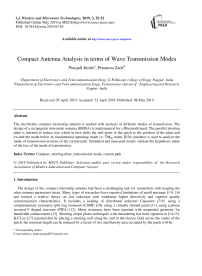Compact antenna analysis in terms of wave transmission modes
Автор: Pranjali Jumle, Prasanna Zade
Журнал: International Journal of Wireless and Microwave Technologies @ijwmt
Статья в выпуске: 3 Vol.9, 2019 года.
Бесплатный доступ
The electrically compact microstrip antenna is studied with analysis of different modes of transmission. The design of a rectangular microstrip antenna (RMSA) is implemented for a Bluetooth band. The parallel shorting plate is inserted to reduce size which in turn shifts the null point of the patch to the position of the plate and excited the mode below its fundamental operating mode i.e. TM00 mode. IE3d simulator is used to analyze the mode of transmission in terms of the current path. Simulated and measured results validate the hypothesis made of the fact of the mode of transmission.
Compact, shorting plate, transmission mode, current path.
Короткий адрес: https://sciup.org/15016969
IDR: 15016969 | DOI: 10.5815/ijwmt.2019.03.03
Текст научной статьи Compact antenna analysis in terms of wave transmission modes
Published Online May 2019 in MECS DOI: 10.5815/ijwmt.2019.03.03
The design of the compact microstrip antenna had been a challenging task for researchers with keeping the other antenna parameters intact. Many types of researches have reported limitations of small antennas [1-8, 16] and formed a relative theory on size reduction with wideband, higher directivity and superior quality communication characteristics. It includes a loading of distributed inductor/ Capacitor [7-9], using a complementary symmetry split ring resonator (CSSR) [10], using a virtually shorted patch [11], using a planar inverted F shaped structure (PIFA) [12]. Many structures have been reported with suspended geometry for bandwidth enhancement [13]. Shorting strips/ plates techniques with meandering has been reported in [14-15]. K.F.Lee [17] reported that by placing a shorting wall along the null in the electric field across the center of the patch, the resonant length can be reduced by a factor of two and thereby area occupied by the patch will be
* Corresponding author.
reduced by a factor of four. A brief analysis of the shorting plate technique presented in [18] in terms of impedances and it is validated by using smith chart.
But very few had demonstrated their electrical properties in terms of transmission modes of wave and their current path. This paper emphasized on the analysis of small antenna in terms of transmission modes of wave and current path. The flow of current decides excitation of different modes in the antenna at fundamental resonating frequencies as well as at the other periodical harmonic frequency yielding multiband or wideband characteristics. The dominant mode of transmission is the mode with the lowest cut- off resonant frequency. If the feed in the rectangular microstrip antenna is placed along the center line of the width W (for the length L >W) as shown in Figure 1, the TM 10 mode is excited which is the lowest order transmission mode with the corresponding cut-off frequency. For the L < W, the TM 01 mode is excited with the feed located at L/2. For a square patch (L = W), both the orthogonal modes TM 10 , and TM 01 exist with identical resonant frequencies.
L > W
TM10
W
—е--
TM01 Ф
♦ X
Fig.1. Transmission of TM10 and TM01 modes for L >W and W > L respectively
In this paper, a size reduction of the microstrip patch antenna is presented by using two shorting plates. Rebekka Porath [19] has reported the fact that a shorting post at (xo, yo) neutralize the electric field at that position which then explicitly separated the zero order mode i.e.TM 00 below its lowest order fundamental resonating Eigen mode i.e. TM 10 . This leads to the important conclusion that there is a frequency below the lowest Eigenvalue. The insertion of a parallel shorting plate in the vicinity of feed position excites that frequency and thereby shifts the operating frequency towards the lower side without changing the dimension of the antenna. Thus, by insertion of a parallel shorting plate in the vicinity of feed position, frequency shifts exactly half of its resonating value. This assumption has been validated by observing the direction of current on the patch.
-
2. Theory
In order to operate in the fundamental TM 10 mode, the length of the patch must be slightly less than λ /2, i.e. implies that the field varies one λ / 2 cycle along the length as the current direction is opposite along length, and there is no variation along the width of the patch. Figure 2a shows the transmission of the TM10 mode. The direction of arrows shows the vector current along the length and width of the patch.
W
E Z
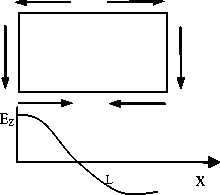
Fig.2a. Transmission of TM 10 modes

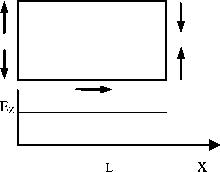
Fig.2b. Transmission of TM 01 modes
The mode TM 01 implies that the field varies one λ / 2 cycle along the width as the current flows in opposite direction along width, and there is no variation along the length of the patch, whereas Figure 2c shows the field varies two λ / 2 cycle along the length yields TM 20 mode as shown from the current direction.
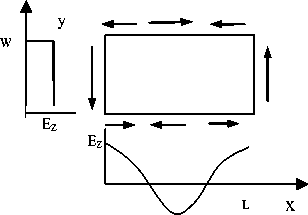
Fig.2c. Transmission of TM 20 modes
-
3. Application to Rectangular MPA’s with Results
This section illustrates the above theory of modes of transmission by applying it to a rectangular microstrip patch antenna (RMSA). Designed of RMSA with FR4 dielectric substrate having ɛr =4.4, h=1.6mm and loss tangent of 0.0022 for the Bluetooth band at operating frequency 2.43 GHz is presented [Figure 3]. With the conventional dimensions of 29*38 mm.sq, the return loss is shown in Figure 4.
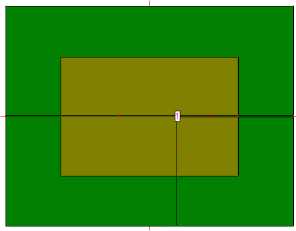
Fig.3. Design of 29*38 mm. sq RMSA on IE3d
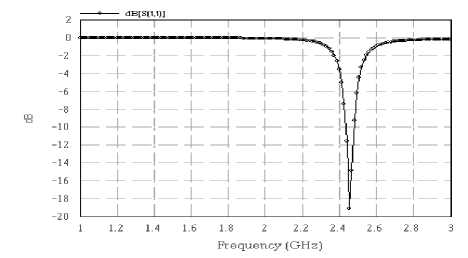
Fig.4. Return loss curve of RMSA
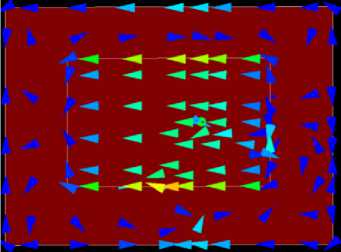
Fig.5. Simulated excited surface current distributions on RMSA at centre resonant frequencies
Fig. 5 shows the simulated excited surface current distributions at centre frequencies. It shows the direction of current is opposite along the width i.e. a variation of the electric field along the width thereby conclusion can be made that TM 01 mode is generated for Bluetooth/ WLAN band. Now, to generate the mode below the lowest resonance frequency two parallel shorting plates have been inserted between a patch and the ground plane without changing the previous dimension [Fig. 6]. In this case, the presence of parallel shorted plates results in a change of inductance of overall structure, which results in decreasing of resonant frequency. This agrees with the result shown in Fig. 7 for a simulated return loss curve of RMSA with parallel shorting plates. By further optimizing spacing between the feed points and shorting plates, good impedance matching can be achieved.
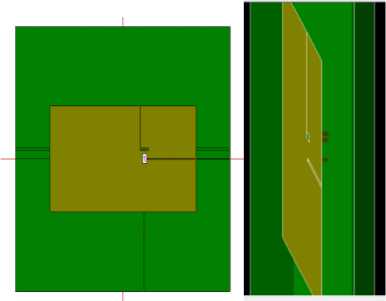
Fig.6. Design RMSA with Parallel shorting plates (Top and side view)
The total length of the antenna becomes close to the one-quarter wavelength (λ/4) of the frequency at 2.43 GHz, which makes it possible to generate a zeroth order mode for Bluetooth/ WLAN operation. This zeroth order resonating mode forms a lower band of antenna at the frequency 1.2 GHz. i.e. below the fundamental dominant mode TM 01 . The other upper bands can be formed by half wavelength resonant mode at around 2.43 GHz, one wavelength resonant mode at 4 GHz, one and a half wavelength resonant mode at 8 GHz. Note that without changing dimension of the patch, a lower resonant mode is achieved, explains compact microstrip antenna design compared to dimension of conventional antenna at 1.2 GHz. Thus the assumption made previously proves correct i.e. by insertion of parallel shorting plate in vicinity of feed position; frequency shifts exactly half of its resonating value.
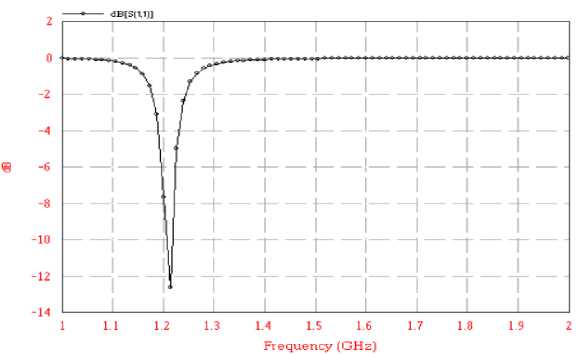
Fig.7. Return loss curve of RMSA with Parallel shorting plates
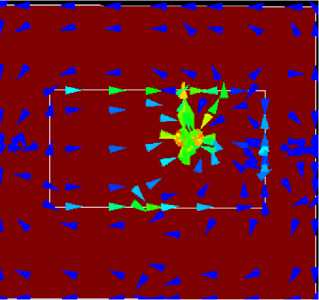
Fig.8. Excited surface currents on the proposed antenna. i.e. RMSA with Parallel shorting plates
Fig. 8 shows the excited surface currents on the proposed antenna. i.e. RMSA with parallel shorting plates. The direction of current explains that along with zeroth order resonant mode i.e. TM 00 , TM 01 , TM 02 , etc can be generated. A Similar analysis of size reduction can be applied to design operating on 2.43GHz i.e. just by optimizing the dimension of design operating on 1.2 GHz yields the size reduction in Bluetooth band. The proposed antenna of 8.3*13 sq.mm size achieves this band. To demonstrate the proposed concept, a prototype of it has been fabricated and tested. The pictures are shown in Fig. 9.
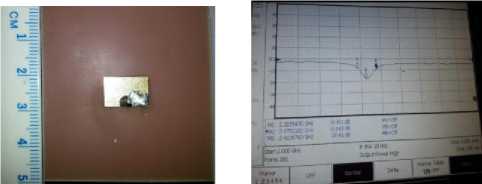
Fig.9. Photograph of fabricated proposed antenna. i.e. RMSA with Parallel shorting plates operating at 2.43 GHz along with its testing results on VNA
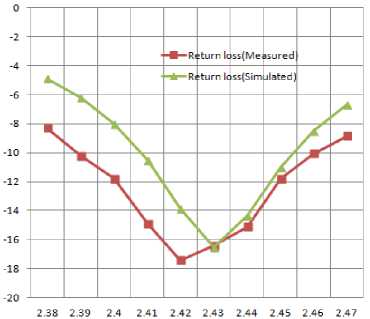
Frequency (GHz)
Fig.10. Simulated and measured reflection coefficient of the miniaturized shorted antenna operating at 2.43 GHz
In Fig. 10, the measured result agrees well with the simulated result within the band of 2.40 to 2.45 GHz. The size reduction up to 90% is clearly demonstrated by the proposed technique. Excitation of zeroth order mode is explained with the demonstration of vector current analysis and has been proved correct with the obtained results.
-
4. Conclusions
A novel Bluetooth band compact antenna with parallel shorting plate is presented in this paper. Transmission mode analysis and direction of current illustration has demonstrated the zeroth order TM00 mode excitation below the lowest resonant mode. This leads to the size reduction compared to conventional type. Both measured and simulated results verified the assumption made by the proposed concept.
Список литературы Compact antenna analysis in terms of wave transmission modes
- R. Garg, P. Bhartia, I. Bahl and A. Ittipiboon: Microstrip Antenna Design Handbook, Norwood, MA, Artech House,USA, 2001.
- G. Kumar and K. P. Ray: Broadband Microstrip Antennas, Norwood, MA, Artech House, USA, 2003.
- Kin-Lu Wong: Compact and Broadband Microstrip Antennas. Copyright 2002 John Wiley & Sons, Inc.
- B. Lee and F. J. Harackiewicz, “Miniature microstrip antenna with a partially filled high-permittivity substrate,” IEEE Trans. Antennas Propag., vol. 50, no. 8, pp. 1160–1162, Aug. 2002.
- B. B. Mandelbrot, The Fractal Geometry of Nature. San Francisco, CA: Freeman, 1983.
- R. Waterhouse, “Small microstrip patch antenna,” Electron. Lett., vol. 31, no. 8, pp. 604–605, Apr. 1995.
- K. L. Wong and Y. F. Lin, “Small broadband rectangular microstrip antenna with chip-resistor loading,” Electron. Lett., vol. 33, no. 19, pp. 1593–1594, Sep. 1997.
- P. Ferrari, N. Corrao, and D. Rauly, “Miniaturized circular patch antenna with capacitors loading,” in Proc. IEEE MTT-S Int. Microw. And Optoelectron. Conf., 2007, pp. 86–89.
- J. H. Lu, C. L. Tang, and K. L. Wong, “Slot-coupled compact broadband circular microstrip antenna with chip-resistor and chip-capacitor loading,”Microw. Opt. Technol. Lett., vol. 18, no. 5, pp. 345–349, Aug. 1998.
- M. S. Sharawi, M. U. Khan, A. B. Numan, and D. N. Aloi, “A CSRR loaded MIMO antenna system for ISM band operation,” IEEE Trans. Antennas Propag., vol. 61, no. 8, pp. 4265–4274, Aug. 2013.
- H. Wong, K. K. So, K. B. Ng, K. M. Luk, C. H. Chan, and Q. Xue, “Virtually shorted patch antenna for circular polarization,” IEEE Antennas Wirel. Propag. Lett., vol. 9, pp. 1213–1216, 2010.
- C. Y. Chiu, K. M. Shum, and C. H. Chan, “A tunable via-patch loaded PIFA with size reduction,” IEEE Trans. Antennas Propag., vol. 55, no. 1, pp. 65–71, Jan. 2007.
- Z. N. Chen and M. Y. W. Chia, “Broadband suspended plate antenna fed by double L-shaped strips,” IEEE Trans. Antennas Propag., vol. 52, no. 9, pp. 2496–2500, Sep. 2004.
- K. L.Wong, C. L. Tang, and H. T. Chen, “A compact meandered circular microstrip antenna with a shorting pin,” Microw. Opt. Technol. Lett., vol. 15, no. 3, pp. 147–149, Jun. 1997.
- Z. N. Chen, “Suspended plate antennas with shorting strips and slots,” IEEE Trans. Antennas Propag., vol. 52, no. 10, pp. 2525–2531, Oct. 2004.
- K.M. Luk, R. Chair, and K. F. Lee, “Small rectangular patch antenna,” Electron. Lett., vol. 34, no. 25, pp. 2366–2367, Dec. 1998.
- K.F.Lee, Y.X.Guo, J.A.Hawkins, “Theory and experiment on microstrip patch antennas with shorting walls” IEE Pror.-Microw. Antennas Puopag.. Vol. 147, No. 6, December 2000.
- Pranjali Jumle and Prasanna Zade, “Analytical Study of Miniaturization of Microstrip Antenna for Bluetooth/WiMax” Springer Advances in Intelligent Systems and Computing (AISC) series. Indexed by: SCOPUS and Springerlink 2016.
- Rebekka Porath, “Theory of Miniaturized Shorting-Post Microstrip antennas” IEEE Transactions On Antennas And Propagation, VOL. 48, NO. 1, JANUARY 2000.

